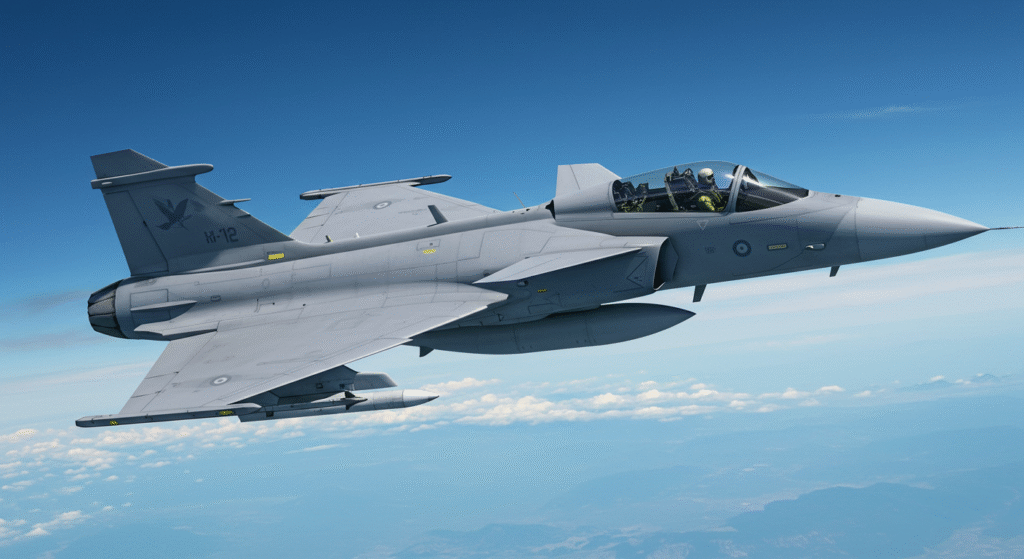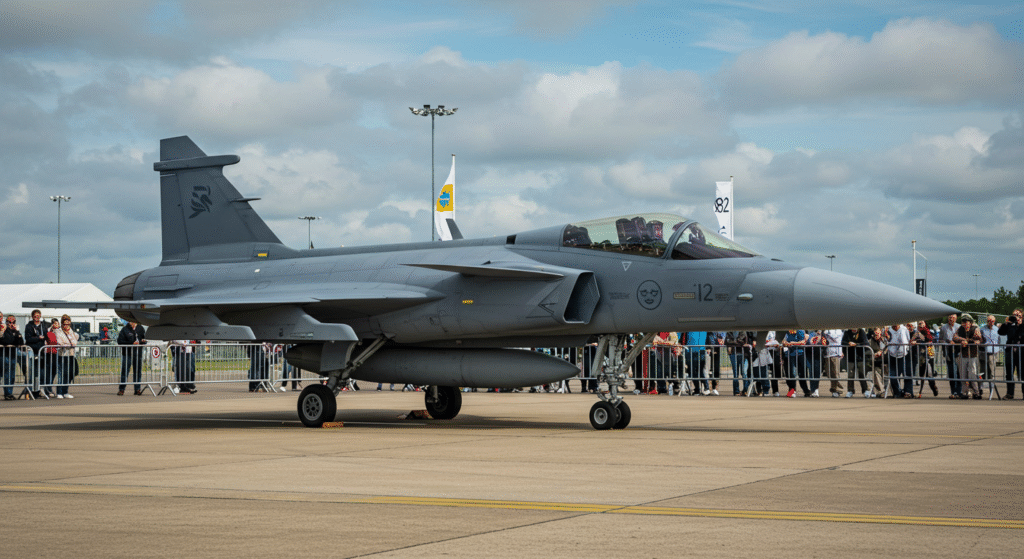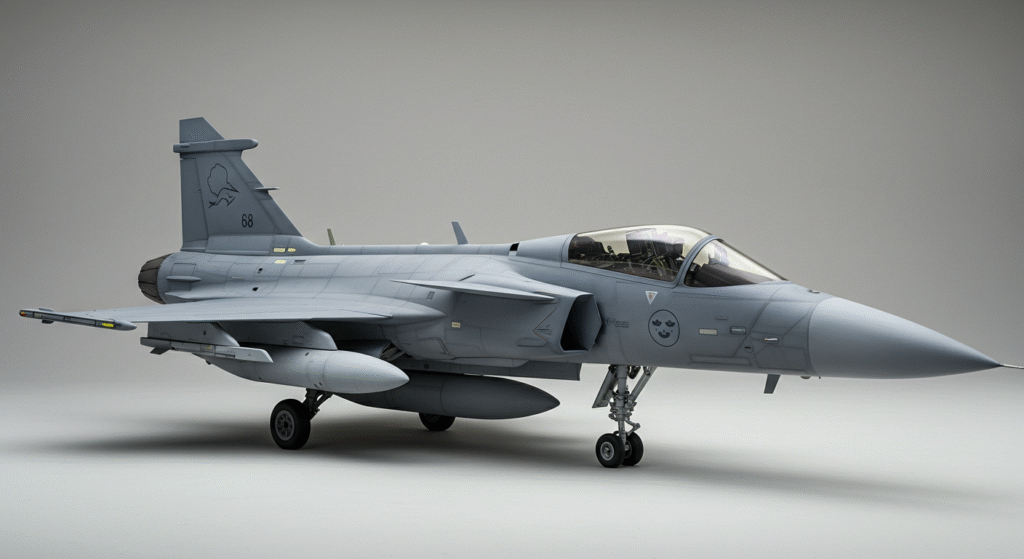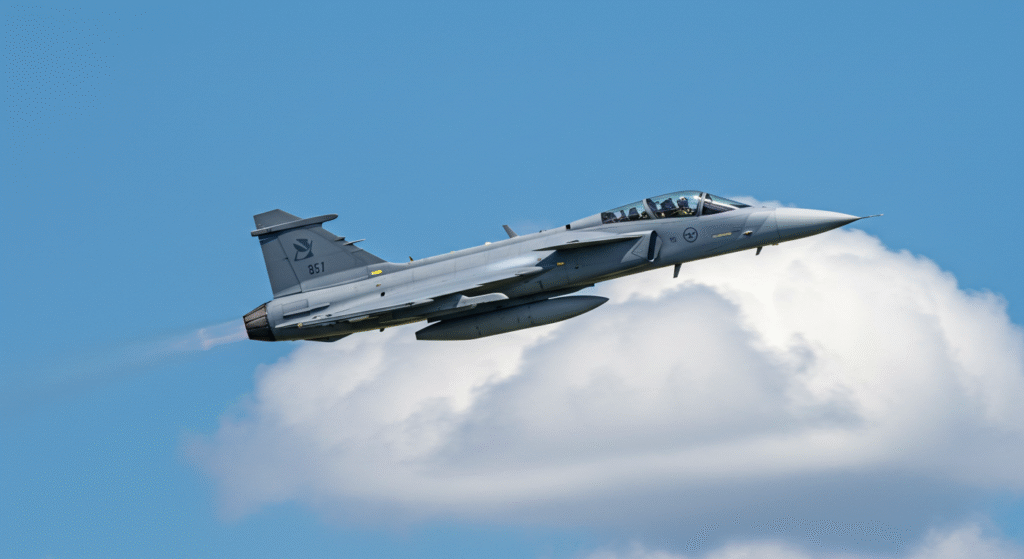Discover the cutting-edge technology and capabilities of the Gripen E/F (JAS 39E/F). Explore how this advanced fighter jet is shaping the future of aviation.
From its origins as a strategically vital, cost-effective national defense solution (Gripen A/B) to its evolution into a globally interoperable force (Gripen C/D), the Saab Gripen has consistently pushed the boundaries of what a lightweight, multirole fighter can achieve. Now, the latest iteration, the Gripen E/F (specifically the single-seat JAS 39E and its two-seat counterpart, the JAS 39F), represents a monumental leap forward, establishing itself as a true fifth-generation capable fighter. Often dubbed the “Smart Fighter,” the Gripen E/F is not just an upgrade; it’s a complete re-imagining, designed to dominate the skies of tomorrow with unparalleled intelligence, adaptability, and combat prowess.
Redefining the “Next Generation”
The journey to the Gripen E/F, initially known as Gripen NG (Next Generation), was driven by the ever-increasing complexity of modern aerial warfare. Facing advanced threats from increasingly sophisticated adversary aircraft and ground-based air defenses, Saab recognized the need for a fighter that could offer a decisive edge. The E/F program began with a clear mandate: significantly enhance performance, extend operational reach, and integrate cutting-edge technologies while retaining the Gripen’s core philosophy of intelligent design and low life-cycle costs.
A New Heart: The GE F414G Engine

One of the most significant advancements in the Gripen E/F is its powerplant. The proven Volvo Aero RM12 engine of earlier variants was replaced by the more powerful General Electric F414G turbofan. This change is transformative:
- Increased Thrust: The F414G delivers approximately 25% more thrust than the RM12, providing enhanced acceleration, climb rate, and sustained supersonic performance. This gives the Gripen E/F a crucial advantage in energy management during combat.
- Greater Payload: The increased thrust allows the Gripen E/F to carry a heavier payload, expanding its weapon options and mission flexibility.
- Improved Fuel Efficiency: While more powerful, the F414G also offers improved fuel efficiency, contributing to the Gripen’s extended range and endurance, further complementing its in-flight refueling capabilities.
Expanded Airframe: More Fuel, More Weapons

To accommodate the more powerful engine and extend its operational envelope, the Gripen E/F features a slightly larger and stronger airframe. This seemingly minor change has profound implications:
- Increased Internal Fuel: The E/F boasts a significantly larger internal fuel capacity, which translates directly into longer unrefueled flight times and greater mission radius. This is critical for sustained operations far from home base.
- More Hardpoints: The Gripen E/F now features 10 hardpoints (compared to 8 on the C/D), allowing it to carry a greater variety and quantity of weapons and external stores. This maximizes its lethality in both air-to-air and air-to-ground roles.
Sensory Superiority: Seeing and Understanding Everything
The true genius of the Gripen E/F lies in its unparalleled sensor suite and intelligent system integration.

Selex ES Raven ES-05 AESA Radar
The E/F is equipped with the state-of-the-art Selex ES Raven ES-05 Active Electronically Scanned Array (AESA) radar. This radar represents a generational leap over previous mechanically scanned radars:
- Enhanced Detection and Tracking: AESA technology provides superior range, resolution, and simultaneous multi-target tracking capabilities. It can scan multiple targets, track them, and even perform ground mapping concurrently, all without physically moving the antenna.
- Low Probability of Intercept (LPI): The AESA radar emits signals that are highly difficult for adversaries to detect and jam, making the Gripen E/F a stealthier and more survivable platform.
- Electronic Warfare Capabilities: The AESA can also be used for electronic attack and jamming, further enhancing the aircraft’s electronic warfare suite.
Skyward-G IRST (Infrared Search and Track)

Complementing the AESA radar is the Skyward-G IRST system. This passive sensor detects heat signatures, providing:
- Stealthy Detection: Unlike radar, IRST doesn’t emit any signals, making it impossible for adversaries to detect its use. This allows the Gripen E/F to covertly detect and track enemy aircraft, even stealth fighters, at significant ranges.
- Enhanced Situational Awareness: The IRST provides an additional layer of situational awareness, particularly in environments where radar might be jammed or against low-observable targets.
Wide Area Display (WAD) Cockpit
The traditional three-MFD cockpit of earlier Gripens has been replaced by a revolutionary Wide Area Display (WAD) in the E/F. This single, massive, high-resolution screen (approximately 19×8 inches) provides:
- Seamless Information Flow: The WAD presents a fused, customizable, and intuitive display of all critical flight, sensor, tactical, and weapon information. Pilots can arrange information as needed, reducing clutter and enhancing comprehension.
- Reduced Workload: With fewer physical buttons and more intuitive controls, the WAD significantly reduces pilot workload, allowing them to focus on the mission.
Intelligent Warfare: The “Smart” in Smart Fighter
Beyond its hardware, the Gripen E/F truly stands out due to its advanced software and intelligent architecture.
Decoupled Avionics Architecture
Saab pioneered a “decoupled” or “modular” avionics architecture for the Gripen E/F. This innovative design separates critical flight control systems from mission-specific software.
- Rapid Upgrades: This separation allows for much faster and cheaper software upgrades for mission systems without having to re-certify the entire aircraft’s flight safety systems. This means the Gripen E/F can continuously adapt to new threats and integrate new capabilities throughout its lifespan, staying ahead of adversaries.
- Future-Proofing: This architecture future-proofs the aircraft, ensuring it remains relevant and competitive for decades to come, a significant cost-saving advantage.
Advanced Electronic Warfare (EW) Suite
The Gripen E/F boasts a 360-degree spherical electronic warfare suite, offering:
- Self-Protection: It can detect, classify, and jam enemy radar and communication systems, significantly increasing its survivability in contested airspace.
- Electronic Attack: Its capabilities extend to active electronic attack, allowing it to disrupt adversary systems and create windows of opportunity for friendly forces.
Global Reach and Future Prospects
The Gripen E/F is currently entering service with both the Swedish Air Force and the Brazilian Air Force. Brazil’s decision to not only purchase the Gripen E/F but also to co-produce a significant portion of the aircraft, including the two-seat Gripen F variant (which is uniquely a Brazilian-led development), underscores the transfer of advanced technology and the trust placed in Saab’s platform. Thailand has also recently announced its intention to procure Gripen E/F aircraft, further expanding its global footprint.
The Gripen E/F is more than just a fighter jet; it’s a testament to continuous innovation. It offers a unique blend of high-end performance, sophisticated sensor fusion, cutting-edge electronic warfare, and unmatched adaptability, all while maintaining the Gripen’s legendary cost-effectiveness. As air forces around the world grapple with budget constraints and evolving threats, the Gripen E/F stands ready as the intelligent choice for the future of air power.

